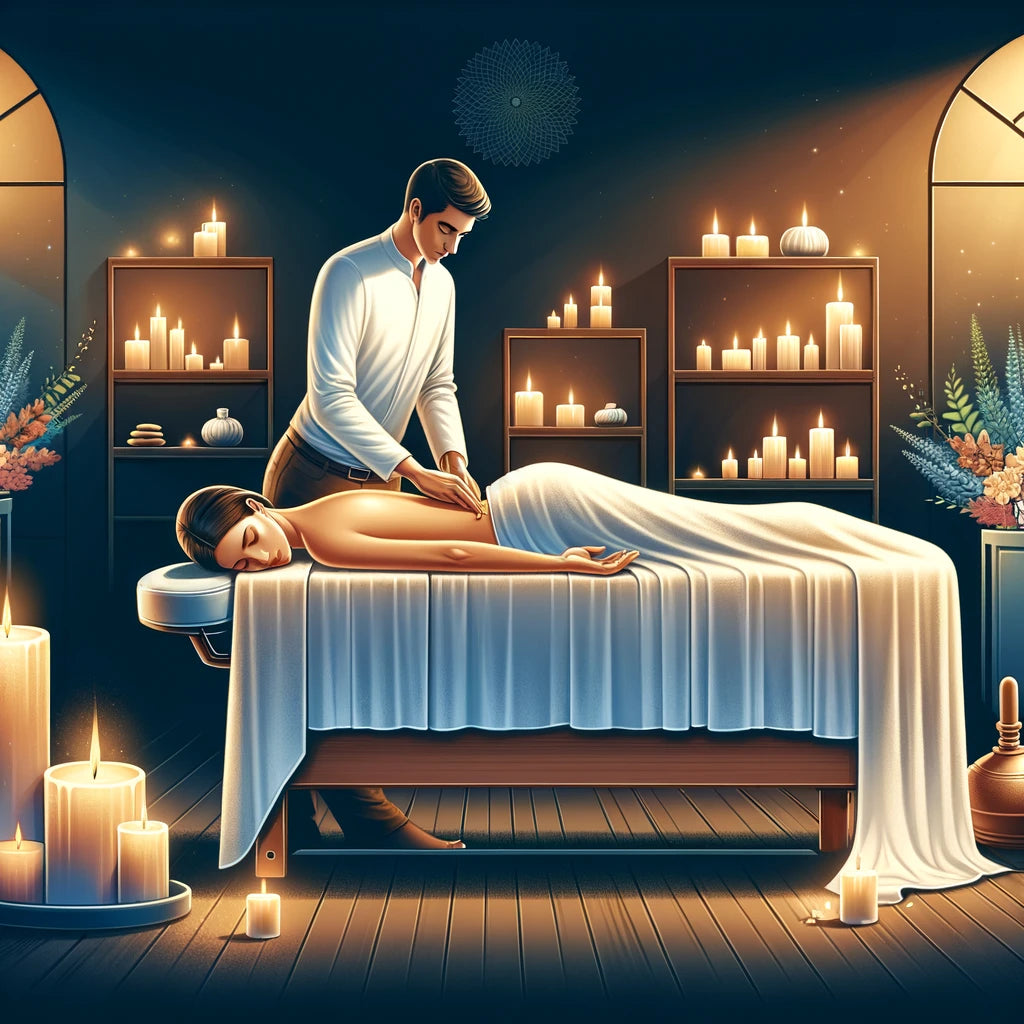
What is done during a full body massage?
Full body massage is a profound method for promoting relaxation and well-being, offering both physical and mental benefits. In this article, we explore exactly what goes into a full body massage, from the preparatory steps to the specific techniques and overall procedure.
Summary of the article:
A full-body massage uses various techniques such as effleurage (stroking), petrissage (kneading), friction (rubbing), and vibration to release muscle tension and promote circulation. This massage encompasses the entire body, including the back, shoulders, arms, legs, head, and neck, and aims to improve physical well-being and mental relaxation. A typical session lasts 60-90 minutes, with individual needs taken into account. Choosing an experienced massage therapist and open communication are crucial for an effective treatment. A modern NAIPO massage chair can also be purchased, providing a full-body massage and saving costs in the long run. Full-body massages are excellent for stress reduction, pain relief, and promoting overall health.
Introduction to full body massage
A full-body massage offers an escape from everyday stress and an opportunity for deep relaxation. It encompasses the entire body, from head to toe, and aims to relieve muscle tension, improve circulation, and promote an overall sense of well-being.
The importance of a full body massage
Physical and mental benefits
The physical benefits include pain relief, improved flexibility, and promoting better circulation. Psychologically, a full-body massage can reduce stress and anxiety and help improve sleep quality.
Improve blood circulation and relieve muscle tension
Various massage techniques stimulate blood circulation, which leads to faster muscle recovery and a better supply of nutrients to the body.
What is done during a full body massage?
Preparation phase
The massage begins in a calm and relaxed atmosphere, often using soft music and aromatic scents to prepare the body and mind for relaxation.
The different techniques and movements
- Effleurage (strokes) : Light, gliding strokes that stimulate lymph flow and warm up the muscles.
- Petrissage (kneading) : Deeper, circular movements that relieve tension and promote blood circulation.
- Frictions : Intensive, targeted movements that target specific problem areas.
- Vibrations and tapping : Fast movements that stimulate and revitalize the muscles.
Areas of application and focused body regions
The massage covers the back, shoulders, arms, legs, head and neck, with special attention paid to areas of high tension.
The process of a full body massage
Duration and frequency
A typical session lasts between 60 and 90 minutes. Frequency can vary depending on individual needs, although regular massages provide the best results.
What you should consider before and after the massage
To maximize the benefits of massage, it is important to be well hydrated before the session and to drink plenty of water after the massage to aid in the elimination of toxins.
Our tip: Alternative to a full-body massage by a masseur
A modern massage chair offers an excellent alternative or complement to traditional full-body massages.
The long-term cost savings are a significant benefit, as purchasing a massage chair can reduce the need for regular visits to a massage therapist.
With the option of daily use, users can benefit from a professional massage experience at any time, which is especially beneficial after long work days or intense workouts.
As a complementary massage method to traditional massages, the NAIPO massage chair supports the maintenance of physical well-being with little to no maintenance required. Investing in a massage chair is therefore not only an investment in your health but also a practical solution for a continuous massage experience at home that is both effective and comfortable.
Who should consider a full body massage?
Recommendations and contraindications
While most people can benefit from a full-body massage, there are certain health conditions that warrant caution. Consulting a doctor is recommended before booking a massage.
The role of the masseur
Choosing the right masseur or masseuse
Choosing a qualified and experienced massage therapist is crucial for an effective and safe massage experience.
Importance of communication and well-being
Open communication about comfort, pressure, and personal boundaries is essential to achieve the best possible outcome.
Different types of full body massages
- Swedish massage : A gentle form of massage, ideal for beginners and those seeking relaxation.
- Deep tissue massage : The aim is to release deep muscle tension and is particularly helpful for chronic pain.
- Aromatherapy massage : Uses essential oils to promote healing and enhance well-being.
- Hot Stone Massage : Use of warm stones to relax muscles and reduce stress.
1. What techniques are used in a full body massage?
A full-body massage is a holistic therapy based on centuries-old knowledge and modern scientific findings. Its goal is to promote the well-being of the entire body. The main techniques include:
- Effleurage (strokes): These gentle, gliding movements warm the muscles, promote circulation, and prepare the body for deeper techniques. They are particularly effective for promoting relaxation and lymphatic flow.
- Petrissage (kneading): Through vigorous, circular movements and kneading of the muscles, underlying tensions are released. This technique helps eliminate muscle stiffness and improve flexibility.
- Friction: Targeted, intensive movements treat specific problem areas. Friction stimulates local blood circulation and can loosen adhesions in the connective tissue.
- Vibrations and tapping: Fast, rhythmic movements invigorate and revitalize the body. They can help loosen muscles and increase feelings of vitality.
These techniques are individually adapted to address the client's specific needs and concerns. A professional full-body massage not only provides relaxation and stress relief but also supports physical health by improving circulation, relieving pain, and promoting mobility.
For those who want to enjoy the benefits of a massage regularly, a NAIPO massage chair offers a practical and effective alternative. With various settings and techniques, a NAIPO massage chair can simulate the aforementioned massage techniques to provide relaxation and relief in the comfort of your own home.
2. What are the health benefits of a full body massage?
Full-body massage is a profound form of therapy that goes far beyond mere relaxation. Scientific studies have proven a multitude of health benefits, including:
- Reduction of stress and anxiety: Regular massages can significantly reduce the level of the stress hormone cortisol in the body while promoting the production of serotonin and dopamine, leading to improved mood and a reduction in anxiety.
- Improved blood circulation: Full-body massage techniques promote blood flow, which leads to better oxygen and nutrient supply to the cells and supports the body's healing processes.
- Pain relief: A full-body massage can provide significant relief, especially for chronic pain such as back pain, headaches, or arthritis. Targeted work on the muscles and connective tissue releases tension and reduces pain.
- Improves sleep quality: The relaxing effect of a full-body massage can lead to deeper and more restful sleep. This is especially beneficial for people with sleep disorders.
A NAIPO massage chair can serve as a complement or alternative to a manual full-body massage, especially when regular visits to a massage therapist are not possible due to time or budget constraints. Its technologically advanced features offer personalized massage experiences tailored to individual needs.
3. How do I prepare for a full body massage?
Preparing for a full-body massage can significantly improve the effectiveness of the treatment and ensure you get the most out of the experience. The following steps are recommended:
- Hydration: Proper hydration before a massage promotes circulation and facilitates the release of tension. It also supports the body in detoxifying after the treatment.
- Light meals: Eat only light meals before the massage to avoid discomfort, as pressure may be exerted on the stomach area during the massage.
- Shower: A warm shower before the massage can help relax your muscles and prepare you for the treatment.
- Communication: Discuss your needs, complaints, and any health restrictions with your masseur in advance. This allows for a personalized massage.
For those who prefer convenience and flexibility, a NAIPO massage chair can be a valuable investment. The ability to access a massage anytime, without requiring any special preparation, offers an excellent way to reap the benefits of a massage on a regular basis.
4. How often should I receive a full body massage for optimal results?
The optimal frequency for a full-body massage depends on various individual factors, including your overall health, stress level, physical needs, and personal goals. In general, many experts recommend a massage once a month to promote general well-being and prevent tension. However, for people with specific conditions such as chronic pain, high physical activity, or significant stress, more frequent treatments—perhaps once a week or every two weeks—may be beneficial for optimal results.
Regularly incorporating full-body massage into your routine not only helps relieve acute discomfort but also supports preventative health. It can help improve circulation, reduce stress symptoms, improve sleep quality, and enhance your overall quality of life.
It's important to listen to your body's signals and adjust the frequency of your massages accordingly. Working closely with a qualified massage therapist or therapist can help develop a customized massage plan tailored to your personal needs and goals. Furthermore, incorporating a massage chair, like the one from NAIPO, can provide a convenient solution for enjoying the benefits of regular massages without the need for constant appointments with a massage therapist. This allows you to maintain flexibility in your routine while reaping the numerous health benefits of a full-body massage.







Leave a comment
This site is protected by hCaptcha and the hCaptcha Privacy Policy and Terms of Service apply.